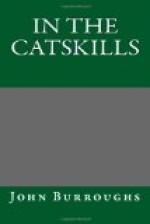In every neighborhood there was always some man who was especially useful at “raisin’s.” He was bold and strong and quick. He helped guide and superintend the work. He was the first one up on the bent, catching a pin or a brace and putting it in place. He walked the lofty and perilous plate with the great beetle in hand, put the pins in the holes, and, swinging the heavy instrument through the air, drove the pins home. He was as much at home up there as a squirrel.
Now that balloon frames are mainly used for houses, and lighter sawed timbers for barns, the old-fashioned raising is rarely witnessed.
Then the moving was an event, too. A farmer had a barn to move, or wanted to build a new house on the site of the old one, and the latter must be drawn to one side. Now this work is done with pulleys and rollers by a few men and a horse; then the building was drawn by sheer bovine strength. Every man that had a yoke of cattle in the country round about was invited to assist. The barn or house was pried up and great runners, cut in the woods, placed under it, and under the runners were placed skids. To these runners it was securely chained and pinned; then the cattle—stags, steers, and oxen, in two long lines, one at each runner—were hitched fast, and, while men and boys aided with great levers, the word to go was given. Slowly the two lines of bulky cattle straightened and settled into their bows; the big chains that wrapped the runners tightened, a dozen or more “gads” were flourished, a dozen or more lusty throats urged their teams at the top of their voices, when there was a creak or a groan as the building stirred. Then the drivers redoubled their efforts; there was a perfect Babel of discordant sounds; the oxen bent to the work, their eyes bulged, their nostrils distended; the lookers-on cheered, and away went the old house or barn as nimbly as a boy on a hand-sled. Not always, however; sometimes the chains would break, or one runner strike a rock, or bury itself in the earth. There were generally enough mishaps or delays to make it interesting.
In the section of the State of which I write, flax used to be grown, and cloth for shirts and trousers, and towels and sheets, woven from it. It was no laughing matter for the farm-boy to break in his shirt or trousers, those days. The hair shirts in which the old monks used to mortify the flesh could not have been much before them in this mortifying particular. But after the bits of shives and sticks were subdued, and the knots humbled by use and the washboard, they were good garments. If you lost your hold in a tree and your shirt caught on a knot or limb, it would save you.
But when has any one seen a crackle, or a swingling-knife, or a hetchel, or a distaff, and where can one get some tow for strings or for gun-wadding, or some swingling-tow for a bonfire? The quill-wheel, and the spinning-wheel, and the loom are heard no more among us. The last I knew of a certain hetchel, it was nailed up behind the old sheep that did the churning; and when he was disposed to shirk or hang back and stop the machine, it was always ready to spur him up in no uncertain manner. The old loom became a hen-roost in an out-building; and the crackle upon which the flax was broken,—where, oh, where is it?




